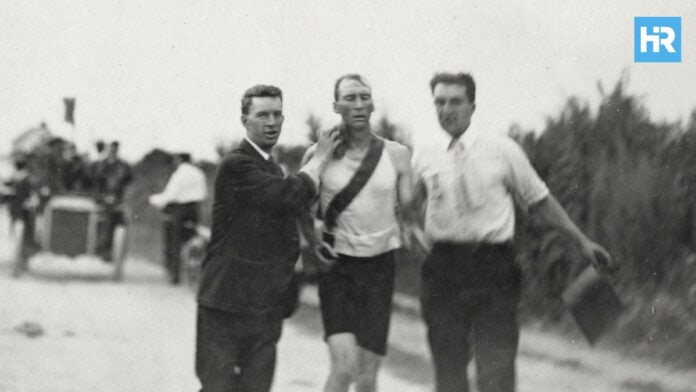The marathon of the 1904 Summer Olympics in St. Louis is remembered as one of the most unusual and controversial races in Olympic history, so controversial that it nearly resulted in the event being removed from the Olympic programme altogether. In 2020, the St. Louis Olympic Legacy Committee installed information panels along the route to tell the story of the race, and markers remain today, including one on the campus of Washington University that reads: “Historical marker: Olympic marathon route of 1904.”
The course did not reach the modern standard of 26.2 miles, measuring instead 24.85 miles. It began and ended on Olympian Way, included several laps of Francis Field Stadium, exited the eastern gate, and continued west along Olympian Way to the city’s outer limits. The St. Louis Marathon still follows parts of this original route.
- The 1904 St. Louis Olympic marathon was run in 33°C (91.5°F) heat with only one water station, and 18 of 32 runners dropped out.
- Thomas Hicks won after being given egg whites, brandy, and strychnine sulphate, while Frederick Lorz falsely finished first after riding in a car.
- The race’s scandals led to the first Olympic anti-doping rule in 1908 and nearly caused the marathon to be abolished.
Brutal Heat, Dust, and Dangerous Conditions
The race took place in the searing heat of 33°C (91.5°F) on dusty, hilly roads. Games director James E. Sullivan, believing incorrectly that dehydration benefited athletes, ordered only one water station to be placed, located near the 12-mile point. Today’s races typically provide up to 15 stations, but in 1904, this lack of water created disastrous consequences.
Of the 32 runners who began, 18 dropped out from exhaustion and dehydration. South African competitor Len Taunyane was chased nearly a mile off course by wild dogs, while Cuban runner Félix Carvajal weakened after eating apples he had stopped to pick and suffered stomach cramps. Even so, Carvajal managed to finish fourth, and Taunyane placed ninth.
The Ordeal of Thomas Hicks
The winner was American Thomas Hicks, who completed the marathon in 3 hours, 28 minutes, and 53 seconds, the slowest Olympic marathon winning time by half an hour. Hicks nearly collapsed in the final 10 miles when his trainers gave him egg whites, brandy, and strychnine sulphate to keep him going. At the time, strychnine was a legal stimulant, though in higher doses it is used as rat poison. In smaller amounts, it acted as a stimulant, but the World Anti-Doping Agency now prohibits it for in-competition use.
Hicks was practically carried to the finish line, and he never ran another marathon. The incident led to the introduction of the first Olympic anti-doping rule. For the London 1908 marathon, Rule 4 declared: “No competitor, either at the start or during, may take or receive any drug. The breach of this rule will operate as a disqualification.”
Frederick Lorz and His Disqualification
The first athlete to cross the finish line was Frederick G. Lorz, born June 5, 1884, in New York City. Lorz worked as a bricklayer and trained at night. His path to the Olympic race began when The New York Times announced on August 6, 1904, that the Metropolitan Association of the Amateur Athletic Union would hold a seven-mile race at Celtic Park on August 13. The top eight finishers would receive paid trips to compete in the Olympic marathon on August 30. Representing the Mohawk Athletic Club, Lorz was named among 19 probable competitors.
During the Olympic marathon, Lorz dropped out after nine miles due to exhaustion and was picked up by his manager in a car. He rode for the next 11 miles until the car broke down, then ran back into the stadium and broke the finish tape to applause. Spectators reported the deception, and officials confronted him. Lorz admitted what had happened, later saying it had been intended as a practical joke.
The Amateur Athletic Union banned him for life, but the punishment was reduced on February 19, 1905, to a six-month suspension after he apologized, and it was determined he had not intended to defraud. Lorz then won the 1905 Boston Marathon with a time of 2 hours, 38 minutes, and 25 seconds.
He was suspended again after competing in an unsanctioned meet at the Thomas Jefferson Club games at Witzel’s Grove in College Point, Long Island, on August 23, 1905. He traveled to the 1908 London Olympics but did not participate in the competition. Lorz died of pneumonia in the Bronx, New York, on February 4, 1914, at the age of 29.
Calls for Abolition
The controversies led to calls for the marathon to be abolished. James E. Sullivan, who had overseen the race, described the event as “indefensible.” Despite this, the marathon returned in London in 1908 and has remained part of the Olympic Games ever since.
The 1904 Olympics were held in St. Louis alongside the World’s Fair, which celebrated the centennial of the Louisiana Purchase and advanced the idea of American imperialism. Within this context, the marathon stood out as the most chaotic event. Several athletes nearly died, including William Garcia, who suffered during the dusty course. Hicks was carried across the finish line after being dosed with strychnine, Taunyane was chased by dogs, Carvajal was sickened by apples, and Lorz used a car. Out of 32 starters, only 14 finished.






